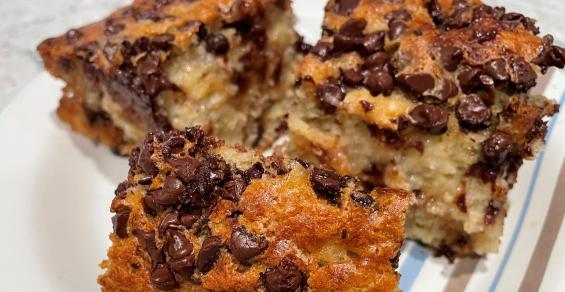What’s Cooking: Check out these two banana-based recipes for a breakfast bar or a sweet treat.
I know we don’t produce bananas in the Midwest, but they certainly are prevalent in Midwest kitchens — whether eaten in hand or made into banana muffins or a banana cake to take the field.
I’m a big fan of slightly ripe — and the really ripe — for my baking. Bananas are incredibly versatile; you can freeze them and use them in a smoothie or bread, saute them in a caramel sauce for a luscious dessert or simply add them to a fruit salad.
As bananas ripen, their starch turns into sugars, which are more easily digested. Mashed bananas can be used like applesauce in place of oil or butter in many recipes to lower the calories.
But first, a little history to help you appreciate this tender fruit.
Bananas are believed to have been the world’s first cultivated fruit, around 8000 to 5000 BC in Southeast Asia. Explorers brought bananas to the New World in the 1600s. By the late 1880s, their popularity soared when bananas started being mass produced. When I was in St. Lucia, one of the main crops was bananas. Farmers grew bananas for Dole, which ships them all over the world. In the U.S., bananas are grown commercially in Hawaii. Most bananas that are imported to the U.S. come from Latin America and South America.
The dessert that made bananas famous was the banana split, invented in 1904 by an employee at the Tassel Pharmacy soda fountain in Latrobe, Pa.
Bananas compete with tomatoes as the world’s most popular fruit. More than 100 billion bananas are eaten every year. Every American eats an average of 27 pounds of bananas per year. And a bit more trivia: There’s a banana museum near Victorville, Calif., that houses more than 17,000 banana-themed items.
Nutritionally, bananas are a great pre-workout snack because of their high level of potassium (good for muscle function). A banana has about 100 calories, no fat, 1 gram of protein, 28 grams of carbohydrates, 15 grams of natural sugar and 3 grams of fiber, along with 450 milligrams of potassium. A medium banana also gives you about a quarter of the vitamin B6 you need daily. B6 helps reduce swelling, protects against developing Type 2 diabetes, aids in weight loss, strengthens the nervous system and helps with the production of white blood cells.
I often have to bust a misconception that bananas shouldn’t be eaten because of their sugar content. The truth is, all fruit has natural sugar. Natural sugars are processed differently than added sugars (in sodas and sweets) because of the fiber and nutrients that make up the fruit.
Here are two of my favorite banana recipes: Chocolate Chip Banana Snack Cake and (healthier) Banana Breakfast Squares. I got the recipe for the snack cake from a treasured church cookbook and my tip: the more ripe the bananas, the better. Ripe bananas will give the cake a sweeter flavor.
Chocolate Chip Banana Snack Cake
1/3 cup butter, room temperature 3/4 cup granulated white sugar1 large egg1 cup mashed ripe banana 1/2 cup milk1 1/2 cups all-purpose flour 3/4 teaspoon baking powder 3/4 teaspoon baking soda 1/4 teaspoon salt 3/4 cup miniature chocolate chips, divided
Preheat the oven to 350 degrees F. Spray an 8-by-8-inch pan with nonstick spray. In a large bowl, use an electric mixer to beat together the butter and sugar until light and fluffy, about two minutes. Beat in the egg. Add in the banana and milk and continue to mix until combined. In a separate bowl, whisk together the flour, baking powder, baking soda and salt. Stir in the dry ingredients just until combined. Stir in 1/2 cup chocolate chips. Scrape the batter into the prepared pan and smooth the top to even it out. Sprinkle 1/4 cup of chocolate chips on top of the batter. Bake 30 to 35 minutes, or until a toothpick tests clean when inserted into the cake. Let the cake cool completely before cutting. Serves eight.
Per serving: 345 calories, 5 grams protein, 54 grams carbohydrates, 14 grams fat, 45 milligrams cholesterol, 2 grams fiber, 310 milligrams sodium
Banana Breakfast Squares
2 1/4 cups all-purpose flour 2/3 cup whole-wheat flour2 teaspoons instant espresso or ground coffee (optional)1 1/2 teaspoons baking soda 3/4 teaspoon baking powder 1/2 teaspoon salt1 cup sugar 3/4 cup packed brown sugar1 stick (8 tablespoons) butter (room temperature) 1/2 cup oil3 large eggs2 teaspoons vanilla extract3 large or 4 medium overripe bananas, cut into chunks 2/3 cup buttermilk 3/4 cup oats (not instant) 1/2 cup finely chopped walnuts or pecans 1/3 cup raisins, dried cranberries or diced soft dates or figs 1/4 cup flaxseeds
Preheat oven to 350 degrees F. Spray or butter a 9-by-13-inch baking pan and dust with flour (or use baker’s spray). Line the bottom of the pan with parchment paper. Whisk both flours, the coffee, baking soda, baking powder and salt together. In a stand mixer, beat both sugars and the butter together at medium speed for about two minutes; pour in the oil and beat for another two minutes, scraping the bowl as needed. Add the eggs, beating for a minute after each. Beat in the vanilla.
With the mixer on medium, drop in the pieces of banana, beating until blended into the batter. Turn off the mixer and add half the flour and pulse to begin blending. Mix on low speed until most of the flour disappears. Pour in the buttermilk and mix. Turn off the mixer and add the remaining flour mixture; pulse and mix only until flour is incorporated.
On low speed, add the oats, nuts, raisins (or other fruit) and flax. Scrape the batter into pan, smoothing the top. Bake for 45 to 50 minutes or until cake pulls away from side. Transfer pan to a rack and let sit for five minutes. Turn it out onto the rack, peel away the paper and turn right side up. Let cool until just warm or room temperature. Cut the cake into 16 squares.
Fargo Ware is a registered dietitian with Southern Illinois University Medical School in Springfield. Send recipe ideas to her at [email protected].





